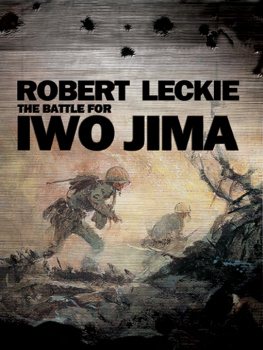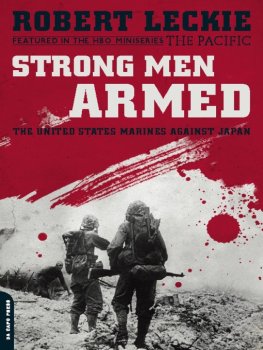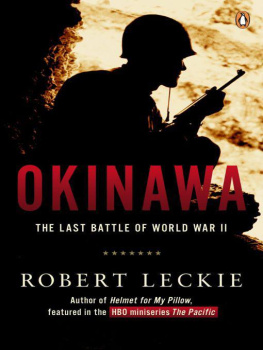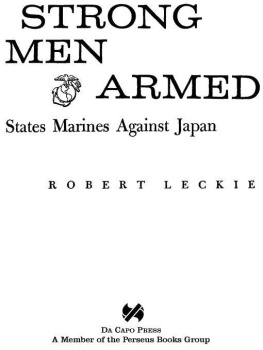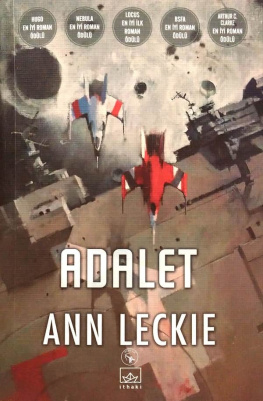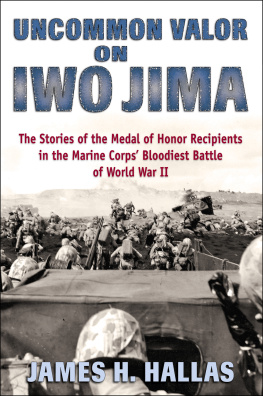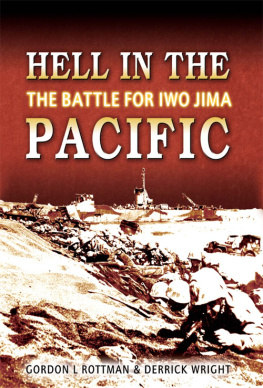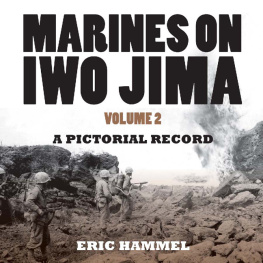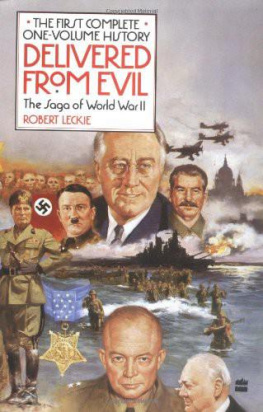Robert Leckie - The Battle for Iwo Jima
Here you can read online Robert Leckie - The Battle for Iwo Jima full text of the book (entire story) in english for free. Download pdf and epub, get meaning, cover and reviews about this ebook. year: 2004, publisher: I Books, genre: History. Description of the work, (preface) as well as reviews are available. Best literature library LitArk.com created for fans of good reading and offers a wide selection of genres:
Romance novel
Science fiction
Adventure
Detective
Science
History
Home and family
Prose
Art
Politics
Computer
Non-fiction
Religion
Business
Children
Humor
Choose a favorite category and find really read worthwhile books. Enjoy immersion in the world of imagination, feel the emotions of the characters or learn something new for yourself, make an fascinating discovery.
- Book:The Battle for Iwo Jima
- Author:
- Publisher:I Books
- Genre:
- Year:2004
- Rating:3 / 5
- Favourites:Add to favourites
- Your mark:
- 60
- 1
- 2
- 3
- 4
- 5
The Battle for Iwo Jima: summary, description and annotation
We offer to read an annotation, description, summary or preface (depends on what the author of the book "The Battle for Iwo Jima" wrote himself). If you haven't found the necessary information about the book — write in the comments, we will try to find it.
The Battle for Iwo Jima — read online for free the complete book (whole text) full work
Below is the text of the book, divided by pages. System saving the place of the last page read, allows you to conveniently read the book "The Battle for Iwo Jima" online for free, without having to search again every time where you left off. Put a bookmark, and you can go to the page where you finished reading at any time.
Font size:
Interval:
Bookmark:
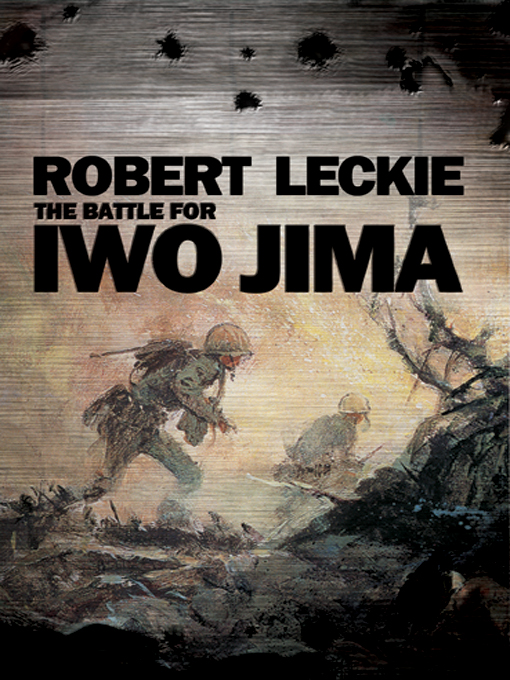
ROBERT LECKIE was born in Philadelphia, the youngest in an Irish-Catholic family of eight children. Growing up in Rutherford, New Jersey, Robert Leckie got his first writing job covering football for the Bergen Evening Record in Hackensack. Upon hearing of the Japanese bombing of Pearl Harbor, Leckie joined the Marines and served nearly three years in the Pacific theater, winning eight battle stars, four Presidential Unit Citations, the Purple Heart, and the Naval Commendation Medal with Combat V. His wartime experiences formed the basis of his acclaimed first book, Helmet For My Pillow.
Following World War II, Leckie continued his journalistic career, writing for the Associated Press and the New York Daily News and serving as an editor for MGM newsreels. Leckie is also the author of March to Glory, The General and numerous other military history and historical fiction books. Robert Leckie died on December 24, 2001.
AVAILABLE NOW
Helmet for My Pillow
The General
March to Glory
By Robert Leckie
Above & Beyond
By Charles Patrick Weiland
Guadalcanal: Starvation Island
By Eric Hammel
Marauder Man
By Kenneth T. Brown
A Gallant Company
By Jonathan F. Vance
Samurai!
By Saburo Sakai with Martin Caidin
and Fred Saito
Zero
By Masatake Okumiya and Jiro Horikoshi
with Martin Caidin
Fork-Tailed Devil: The P-38
The B-17: The Flying Forts
By Martin Caidin
Vietnam: A Reader
By the Editors of Vietnam magazine
Operation Vulture
By John Prados
Company Commander Vietnam
By James Estep
What They Didnt Teach You About The Civil War
What They Didnt Teach You About World War II
By Mike Wright
48 Hours to Hammelburg
by Charles Whiting
Black Devil Brigade
By Joseph A. Springer
Silence on Monte Sole
By Jack Olsen
Blue Skies and Blood
By Edwin P. Hoyt
THE BATTLE
FOR IWO JIMA
By
ROBERT LECKIE
Maps by Ted Burwell

new york
www.ibooksinc.com
An ibooks, inc. Book
All rights reserved, including the right to reproduce this
book or portions thereof in any form whatsoever.
Distributed by Simon & Schuster, Inc.
1230 Avenue of the Americas, New York, NY 10020
ibooks, inc.
24 West 25th Street
New York, NY 10010
The ibooks World Wide Web Site address is:
http://www.ibooksinc.com
Copyright 1967 by Robert Leckie
and 2004 the Robert Leckie Estate
All Rights Reserved
Front Cover Design by Matt Postawa
ISBN: 1-59019-454-3
To Angelo Bertelli and Douglas Boyd
Two Good Marines Who Fought at Iwo Jima
1. THE MARINES GO IN
2. THE IMPORTANCE OF IWO
3. THE TERRIBLE FIRST DAY
4. THE FLAG FLIES AT SURIBACHI
5. THE UP-ISLAND DRIVE
6. INTO THE MEATGRINDER
7. BREAKTHROUGH
8. TILL THE LAST MAN
ORDER OF EVENTS IN THE INVASION
NOTE ON UNIT STRENGTH
MARINES WHO WON THE MEDAL OF HONOR
On February 19, 1945, the United States brought the war in the Pacific to the front doorstep of Japan. Iwo Jima was a tiny dark island four and a half miles long and two and a half miles wide. Located only 660 miles south of Tokyo, it looked from the air like a lopsided, black pork chop.
On the bright, clear morning of that fateful Monday, a vast armada of 485 American ships completely surrounded Iwo Jima. Battleships and cruisers stood off in the distance to batter Japanese positions and pin down the enemy so that the assault troops might get safely ashore. Great flashes of orange flame erupted from the ships guns as they sent huge shells howling toward their targets. Closer still, graceful destroyers seemed to dance off shore, dueling Japanese gun batteries, while rocket ships turned broadside to unleash flights of missiles.
Out of sight were the aircraft carriers, from whose decks had come the bombers and fighters that were also striking at Iwo. The planes flashed in and out of clouds of smoke and dust with bombs, rockets and machine guns. In addition, a formation of Liberators had flown in from faraway bases in the Marianas to make the little island quiver and shake with carpets of big bombs.
It did not seem possible that anythingespecially human beingscould survive on little Iwo. And indeed there was no answering fire from the tiny dark island. All was strangely quiet. To the south, the volcano Mount Suribachi rose 550 feet above the sea. Just north of it, on the islands east coast, were the landing beaches: silent, black and sinister. Then fading away to the north was a jumble of ridges rising to a high plateau. This was Iwo Jima, or Sulphur Island, which 70,000 United States Marines had come to claim for the Stars and Stripes.
As the aerial bombardment slackened, the first waves of Marines prepared to attack. Holding their rifles and machine guns, their flame throwers and bazookas, they filed down to the bottom deck of their landing ships. There they clambered aboard amphibious tractors, or amtracks. The amtracks, which the Japanese called little boats with wheels because of the gears on which their tracks turned, could churn through water and roll over land. Like great jaws, the forward bow doors of the landing ships yawned and opened wide. There was a great coughing and a roar of motors starting. Inside the landing ships the air became blue with smoke. Some of the Marines had begun to sweat, even though the air was crisp and cool. As they brushed aside beads of perspiration, they smeared the antiflash cream they had put on their faces to prevent burns.
Then the amtracks waddled forward. Like so many ducks, they spilled out of their mother ships, dropped into the water and formed landing circles. Around and around they circled, waiting for the order to attack. The order came. One by one the amtracks swung wide into the attack line. Gradually gathering speed, they went churning toward Iwos terraced beaches. The sea bombardment was lifting; the last aerial strike had come and gone. The sound of the amtrack motors was rising to a roar. Marines crouched anxiously below the gunwales, braced for the enemys long-awaited answering fire. None came.
Beneath them, the Marines felt a jolt and a lurch. Then they were on their feetweapons held highvaulting over the side and sinking ankle-deep into the warm, black sands of Iwo Jima.
IWO
In the fall of 1944, the American high command had decided to capture Iwo Jima. The little island was important because it was only 660 miles from Tokyo. Iwo and the bigger island of Okinawa were to be used as bases for the final invasion of Japan.
But after the big B-29 Superfort bombers began to raid Japan from the recently captured chain of islands called the Marianas, the Americans realized that it was imperative to capture Iwo Jima as soon as possible. For Iwo lay on a direct line between the Marianas and Japan, and the Japanese on the island could give advance warning of the bombers approach. The enemy would then put up massive antiaircraft barrages and stack fighter planes high in the sky, waiting to pounce on the B-29s. If the fighters could not shoot down a B-29, then they tried to ram it. As a result, the Americans were losing far too many Superforts over Japan. Others were so crippled by the attacks that they crashed into the sea during the long 1500-mile trip back to the Marianas.
Font size:
Interval:
Bookmark:
Similar books «The Battle for Iwo Jima»
Look at similar books to The Battle for Iwo Jima. We have selected literature similar in name and meaning in the hope of providing readers with more options to find new, interesting, not yet read works.
Discussion, reviews of the book The Battle for Iwo Jima and just readers' own opinions. Leave your comments, write what you think about the work, its meaning or the main characters. Specify what exactly you liked and what you didn't like, and why you think so.

